For Most Audiences, How Is Reading Online Different From Reading From a Printed Page?
You Won't Terminate This Commodity
Why people online don't read to the end.

Photograph by Roslan Rahman/AFP/Getty Images
I'yard going to keep this brief, considering yous're not going to stick effectually for long. I've already lost a agglomeration of you. For every 161 people who landed on this page, about 61 of yous—38 pct—are already gone. Y'all "bounced" in Spider web traffic jargon, meaning you spent no time "engaging" with this page at all.
So at present there are 100 of you left. Nice circular number. But not for long! We're at the bespeak in the folio where you take to scroll to run across more. Of the 100 of you who didn't bounce, v are never going to scroll. Good day!
OK, fine, good riddance. So nosotros're 95 at present. A friendly, intimate crowd, merely the people who want to be here. Thanks for reading, folks! I was beginning to worry virtually your attending span, even your intellig … look a 2nd, where are yous guys going? You lot're tweeting a link to this article already? You haven't fifty-fifty read information technology nevertheless! What if I proceed to advocate something truly awful, similar a constitutional subpoena requiring that we all blazon two spaces subsequently a period?
Expect, agree on, at present you guys are leaving too? Y'all're going off to comment? Come on! There's nil to say even so. I oasis't fifty-fifty gotten to the nut graph.
I better get on with information technology. So hither'southward the story: Only a small number of you are reading all the way through manufactures on the Web. I've long suspected this, because so many smart-alecks spring in to the comments to make points that get mentioned afterwards in the slice. But now I've got proof. I asked Josh Schwartz, a information scientist at the traffic analysis firm Chartbeat, to look at how people ringlet through Slate manufactures. Schwartz too did a like analysis for other sites that utilise Chartbeat and have allowed the business firm to include their traffic in its aggregate analyses.
Schwartz's data shows that readers tin't stay focused. The more I type, the more than of yous melody out. And it's non only me. Information technology's not but Slate . It's everywhere online. When people country on a story, they very rarely get in all the way down the page. A lot of people don't fifty-fifty get in halfway. Even more dispiriting is the relationship between scrolling and sharing. Schwartz'due south data advise that lots of people are tweeting out links to manufactures they haven't fully read. If you see someone recommending a story online, you lot shouldn't assume that he has read the thing he's sharing.
OK, we're a few hundred words into the story now. According to the information, for every 100 readers who didn't bounciness upwardly at the top, there are about l who've stuck around. Only one-half!
Take a wait at the following graph created by Schwartz, a histogram showing where people stopped scrolling in Slate manufactures. Chartbeat tin can track this information considering it analyzes reader behavior in existent time—every time a Spider web browser is on a Slate page, Chartbeat's software records what that browser is doing on a 2nd-past-second basis, including which portion of the page the browser is currently viewing.
A typical Web commodity is near 2000 pixels long. In the graph below, each bar represents the share of readers who got to a particular depth in the story. There'south a spike at 0 percent—i.east., the very superlative pixel on the page—because 5 percent of readers never scrolled deeper than that spot. (A few notes: This graph but includes people who spent whatsoever time engaging with the folio at all—users who "bounced" from the page immediately subsequently landing on it are not represented. The X axis goes beyond 100 percentage to include stuff, like the comments department, that falls below the 2,000-pixel marking. Finally, the spike most the end is an anomaly acquired by pages containing photos and videos—on those pages, people scroll through the whole page.)
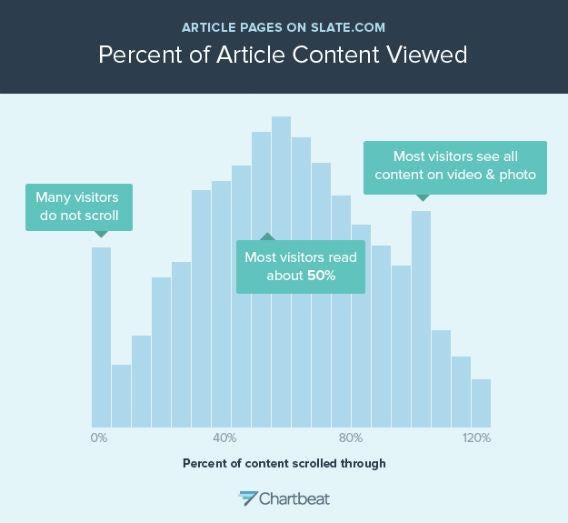
Courtesy of Chartbeat
Chartbeat'southward data shows that most readers whorl to most the l per centum mark, or the 1,000th pixel, in Slate stories. That's not very far at all. I looked at a number of contempo pieces to see how much you'd get out of a story if you lot only made it to the 1,000th pixel. Accept Mario Vittone'southward piece, published this week, on the alarm signs that someone might be drowning. If the meridian of your browser reached only the 1,000th pixel in that article, the lesser of your browser would be at around pixel number 1,700 (the typical browser window is 700 pixels tall). At that point, y'all'd only have gotten to alarm signs No. 1 and 2—you'd have missed the fact that people who are drowning don't moving ridge for assist, that they cannot voluntarily control their arm movements, and 1 other warning sign I didn't get to because I oasis't finished reading that story yet.
Or look at John Dickerson's fantastic commodity about the IRS scandal or something. If yous only scrolled halfway through that astonishing slice, you would have read just the first 4 paragraphs. Now, trust me when I say that across those four paragraphs, John made some really adept points about whatever information technology is his article is about, some strong points that—without spoiling it for y'all—you lot really have to read to believe. But of form you didn't read it because you got that IM and so you had to expect at a video and so the telephone rang …
The worst thing nearly Schwartz'south graph is the big fasten at goose egg. Well-nigh 5 pct of people who land on Slate pages and are engaged with the page in some way—that is, the page is in a foreground tab on their browser and they're doing something on it, similar perhaps moving the mouse pointer—never curlicue at all. Now, practise you know what you get on a typical Slate page if you never coil? Bupkis. Depending on the size of the motion-picture show at the summit of the folio and the height of your browser window, you'll get, at most, the get-go judgement or ii. There's a proficient chance you'll see none of the article at all. And however people are leaving without even starting. What's wrong with them? Why'd they even click on the page?
Schwarz's histogram for articles across lots of sites is in some ways more than encouraging than the Slate information, just in other means even sadder:

Courtesy of Chartbeat
On these sites, the median coil depth is slightly greater—most people get to 60 percent of the article rather than the 50 percent they reach on Slate pages. On the other mitt, on these pages a higher share of people—10 percent—never scroll. In general, though, the story beyond the Web is like to the story at Slate : Few people are making it to the end, and a surprisingly large number aren't giving articles any chance at all.
Nosotros're getting deep on the folio here, and so basically just my mom is even so reading this. (Thank you, Mom!) But permit'southward talk about how scroll depth relates to sharing. I asked Schwartz if he could tell me whether people who are sharing links to articles on social networks are likely to take read the pieces they're sharing.
He told me that Chartbeat can't directly track when individual readers tweet out links, then it tin't definitively say that people are sharing stories before they've read the whole matter. But Chartbeat can look at the overall tweets to an article, and then compare that number to how many people scrolled through the commodity. Here'due south Schwartz's analysis of the relationship between scrolling and sharing on Slate pages:
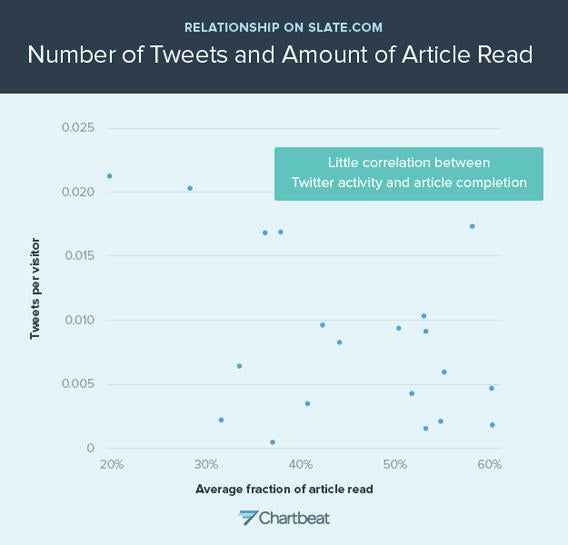
Courtesy of Chartbeat
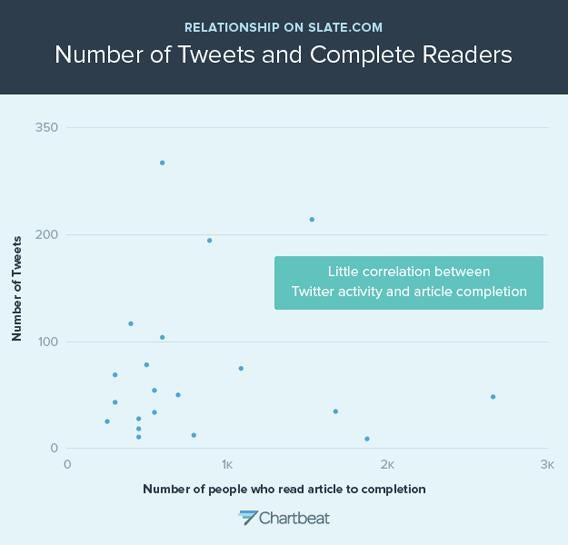
Courtesy of Chartbeat
And hither's a similar expect at the relationship betwixt scrolling and sharing beyond sites monitored by Chartbeat:
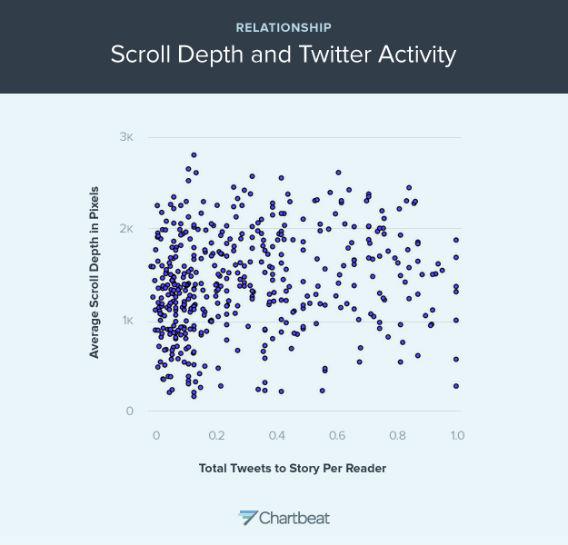
Courtesy of Chartbeat
They each evidence the same matter: There'due south a very weak relationship between gyre depth and sharing. Both at Slate and across the Spider web, articles that get a lot of tweets don't necessarily get read very deeply. Articles that get read deeply aren't necessarily generating a lot of tweets.
Equally a writer, all this data annoys me. It may non be obvious—especially to you guys who've already left to watch Arrested Development—but I spend a lot of time and free energy writing these stories. I'm fifty-fifty careful well-nigh the stuff at the very end; like right now, I'thousand wondering near what I should say next, and whether I should include these two other interesting graphs I got from Schwartz, or perhaps I should skip them because they would cause folks to tune out, and maybe it'due south time to wrap things up anyhow …
Only what's the point of all that? Schwartz tells me that on a typical Slate page, only 25 percent of readers brand it past the i,600thursday pixel of the page, and we're way beyond that now. Sure, like every other writer on the Spider web, I desire my articles to exist widely read, which means I desire yous to Similar and Tweet and email this piece to everyone you know. Simply if you had whatsoever inkling of doing that, yous'd have done it already. Y'all'd probably accept done it just after reading the headline and seeing the picture show at the height. Zilch I say at this point matters at all.
So, what the hey, hither are a couple more than graphs, after which I hope I'll wrap things up for the scattering of folks who are nevertheless left around hither. (What losers you are! Don't you take anything else to practise?)
This heatmap shows where readers spend most of their time on Slate pages:
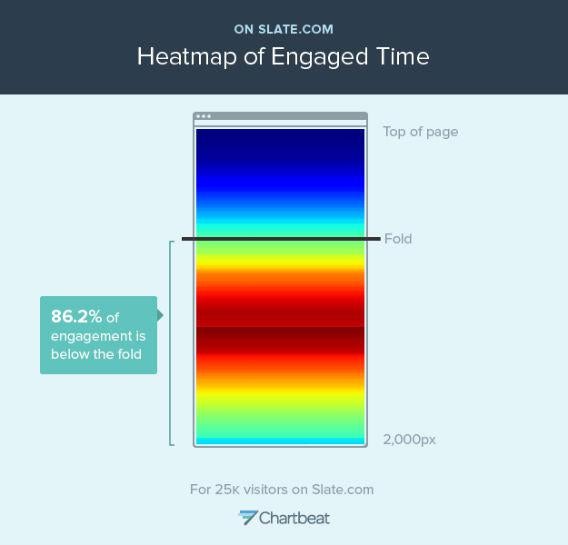
Courtesy of Chartbeat
And this one shows where people spend fourth dimension across Chartbeat sites:
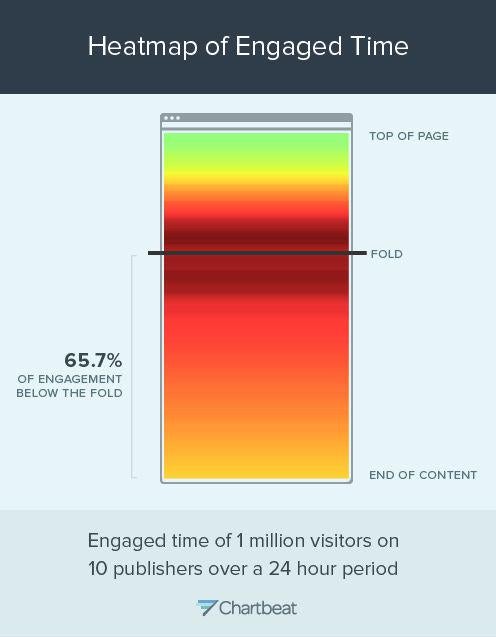
Courtesy of Chartbeat
Schwartz told me I should exist very pleased with Slate 'southward map, which shows that a lot of people are moved to spend a significant amount of their fourth dimension below the initial gyre window of an article page. On Chartbeat'southward amass data, almost two-thirds of the time people spend on a page is "beneath the fold"; on Slate , that number is 86.2 per centum. "That's notably good," Schwartz told me. "Nosotros generally meet that higher-quality content causes people to gyre farther, and that's one of the highest below-the-fold engagement numbers I've always seen."
Yay! Well, in that location's one large caveat: It'southward probably Slate 'southward page blueprint that's boosting our number there. Since you lot unremarkably have to scroll beneath the fold to come across just about whatever office of an article, Slate 'due south below-the-fold engagement looks really great. Simply if articles started in a higher place on the page, it might not look as good.
In other words: Ugh.
Finally, while I hate to see these numbers when I consider them as a author, as a reader I'1000 non surprised. I read tons of articles every twenty-four hour period. I share dozens of links on Twitter and Facebook. Simply how many exercise I read in full? How many exercise I share subsequently reading the full thing? Honestly—and I feel comfortable proverb this because even mom'due south stopped reading at this point—not too many. I wonder, besides, if this applies to more than only the Web. With ebooks and streaming movies and Television shows, it's easier than e'er, now, to switch to something else. In the by year my married woman and I have watched at least a vi movies to near the 60 percentage marker. There are several books on my Kindle I've never experienced past Chapter 2. Though I loved it and recommend it to everyone, I never did end the British version of the teen drama Skins. Battlestar Galactica, besides—bailed on information technology in the middle, hoping to i day leap dorsum in. Will I? Probably not.
Perchance this is just our cultural lot: Nosotros alive in the historic period of skimming. I want to stop the whole thing, I really do. I wish yous would, too. Really—stop quitting! But who am I kidding. I'm busy. You lot're decorated. There's ever something else to read, watch, play, or swallow.
OK, this is where I'd come with some clever ending. But who cares? You certainly don't. Let's but become with this: Kicker TK.
Source: https://slate.com/technology/2013/06/how-people-read-online-why-you-wont-finish-this-article.html
0 Response to "For Most Audiences, How Is Reading Online Different From Reading From a Printed Page?"
Post a Comment